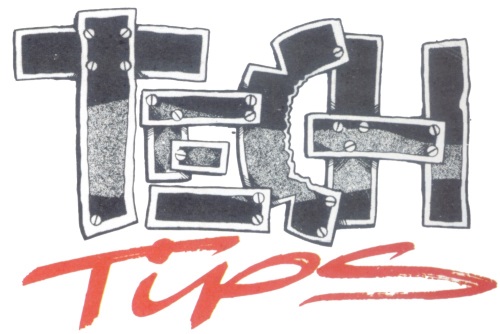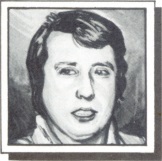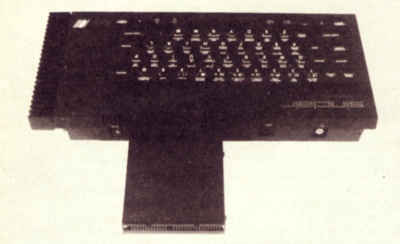

Switch to the Plus D and save £105?

After last month’s unveiling of Miles Gordon Technology’s alternative Spectrum — SAM — IAN CULL now reviews MGT’s alternative to the +3, the Plus D disk drive add-on. Deepening Amstrad’s woes further Ian also disparages the +2A, while updating his DICE review and looking over yet more techie mags.
DUE TO Amstrad’s predictable refusal to offer hardware for Spectrum owners wishing to upgrade to +3 standards, the only option might seem buying a completely new computer. In fact, this is far from the case thanks to Miles Gordon Technology. Their solution to the problem is the Plus D Interface and 780K 3.5 inch disk drive for £139.95 in kit form.
‘Loading a 48K snapshot takes about 7 seconds’
Comparing a 48K or 128K Spectrum with Plus D fitted, to the official disk machine, the +3, is an interesting exercise. The Plus D is a flat, but long, interface, that when fitted to a Spectrum sticks out enough to almost double its length. A cable connects it to the metal-cased disk drive, which has a separate power supply (another cable). There is a built-in parallel printer interface, but no serial ports. This obviously means a lot more desk space is taken up.
Another slight problem is that your Spectrum isn’t designed to access the disk drive. When powered up the Plus D interface has only minimal internal software — enough to ‘boot’ a disk, which loads in the full program. However, a configuration program, supplied on tape, allows the specifics of your particular disk drive set-up to be programmed into a system file, which is then stored on disk for future booting — the tape will probably never be needed again. Booting takes only about 2.5 seconds. While the +3 obviously does not need this, the MGT drive offers much more storage space, 780K in all, or four times as much as can be held on a +3 disk without manually flipping it over. The drive is also very fast, the SAVE of 16K took 4.6 seconds, the LOAD just 2.2 seconds. Formatting, however, takes a very slow 110 seconds (18 for the +3, but you need to do it four times to get the same amount of disk storage space).
‘It would be possible to write 390K programs’
The Plus D can also emulate
the Microdrive syntax, making it
reasonably compatible with
Spectrum business software
(the +3 emulates tape loading/saving, but little else), but also
has a simpler syntax (still not as
easy to type as the +3 though).
Another +D advantage is a built-in
‘magic button’ (saving the
cost of a Multiface 3) which
allows screen dumps, and 48K
or 128K snapshots (or copies of
programs) to be taken. Also on
the plus side is that true disk
data files can be created — it is
thus possible to open streams to
files, and PRINT to, or INPUT from,
the file via the stream. It would be
possible to write programs
handling 390K or more of data in
this way!
Snapshots cannot be loaded
until the disk has been booted,
so loading a 48K snapshot (Advanced
Pinball Simulator) takes
about seven seconds, and five
key presses (using the LOAD p5
shortcut). The +3, using Multiface
3, takes 19 seconds (and
ten key presses) to load the
same game — however, there is a
little extra 128K-specific code to
be loaded. The one bonus is that
Multiface packs the games on
disk, allowing more to be fitted
on the disk (e.g. 60K for a 128K
game on the +3, as against
128K on the Plus D). But then,
the Plus D has more space available
on the disk.
‘The +3 is quite incompatible with other Spectrums’
You should also remember that the +3 is quite incompatible with older Spectrums (except the +2A), and much hardware and some software will not run on it. Fitting a Plus D to your old Spectrum will save you £105 (+3 and Multiface 3 = £245), and run everything you already own (NB: the Plus D is NOT compatible with my Alphacom printer or Multiface 1, though).

TO MAKE best use of the Plus D, additional hacker programs are needed since it has few functions apart from the ‘snapshot’ one. Genie, for all Multifaces except the +3, has for some time allowed hackers to stop a game or other program in mid-flight, call up a disassembler/editor, then continue the stopped program as if nothing had happened. Now, two programs for the Plus D allow similar tasks to be carried out. The ‘official’ Pick-Poke-It (PPI) from MGT themselves and Plus D Hacker (PDH) from INDUG. PPI costs £14.95, against PDH which costs just £3.95!
Both programs are supplied on tape, so that they can be configured onto any Plus D set up. In both cases, a new Plus D system file is created on disk, which will auto-initialise the hack-program whenever the disk is booted. Other necessary files take 15K of disk space for PPI and 20.5K for PDH.
Genie fits totally into the Multiface RAM, so is instantly available when the magic button is pressed. Both PPI and PPH, however, store their code on disk, and take some time to appear when the button is pressed — PPI takes 6 seconds, PDH takes 7.5 seconds. However, PDH has a second mode, in which the screen is not saved (useful in some cases) which appears almost instantly!
Once loaded, both programs offer similar facilities (though PDH offers some unusual additional routines), but the routines are also called in from disk as required (eg 2 seconds to call up the disassembler) — PPI is quicker here, but PDH is smart enough to not reload the routine if you have just used it. One problem with both programs is that some of the Spectrum RAM is taken up with the hack-program itself (just the screen on PDH, but all memory up to 23755 on PPI). PDH does not deal with this, indeed it is possible to disassemble/edit PDH itself (or crash it, if you’re not careful). PPI, however, allows the ‘missing’ memory to be loaded into the 48K section, and examined there — this is detailed under the 128K bank functions as an appendix, so 48K users may miss it!
‘PDH offers some unusual additional routines’
Both of the programs have a poor keyboard interface; there is a tendency for double registering of keys, etc. This is particularly annoying in PDH, since there is no delete function. You have to let the selected function begin, then abort it (very dangerous if the selected function was a fill memory, or similar).
PPI offers, once the button has been pressed, the normal snapshot functions, as well as a disassembler; memory editor; search routine; access to Z80 registers; (128K) bank switch and search; block find and fill, and graphics search. Output can be sent to the printer with both.
‘Both programs have a poor keyboard interface’
Of the two packages, PPI is far
easier to use. When disassembling
or displaying memory, one
page at a time is given, then the
menu can be recalled, the same
function restarted, or the following
page displayed. PDH simply
disassembles/displays until
ENTER is pressed (to pause the
display), SPACE (which restarts) or
M (to recall the main menu). PDH
only uses the bottom third of the
screen, whereas PPI uses the
whole screen. POKEing is also
simpler with PPI, allowing entry
of message strings as well as
decimal/hex numbers — PDH
has a POKE facility within a general
Z80 register page and only
accepts decimal numbers.
However, PDH offers additional
facilities to PPI — in particular,
semi-automated infinite
life POKE searches (though
nowhere near as sophisticated
as the Multiface Lifeguard program),
and a graphics search
mode. This is quite intriguing, as
it allows memory to be scrolled
around onscreen in many ways,
giving a reasonable chance of
finding where a games’ graphics
are held in memory. Another
PDH bonus is an additional program
that can be loaded into the
Plus D over the top of the hack-program (but taking no main
Spectrum memory), which gives
the Spectrum some graphics
drawing functions. For example.
RUN*1 (followed by 7 arguments!)
allows an area of memory to be
defined as a graphic; RUN*d will
delete lines of BASIC etc. One
problem is that these routines
use information from the hack-program,
which cannot be run at
the same time.
‘PDH has semi-automated infinite life POKE searches’
In summary, both programs do their job reasonably well. PPI is a well written program, with excellent documentation — but it is very expensive. PDH is less ‘professional’, but offers a number of unusual additional functions, and is very good value. Documentation for PDH is not too good (and there is a warning of possible crashes on 128K Spectrums). The average Spectrum user would be quite happy with Plus D Hacker, but serious game hackers may wish to pay the additional money for Pick-Poke-It, to get a more reliable product.
AFTER REVIEWING Kobrasoft’s back-up program DB1 in Issue 60 I promised a quick update on DICE (now Version 2) also from Kobrahsoft. Refer back to Issue 57 for the full review.
The main menu has now lost the COPY command (which has been moved to within the FILES menu, so that all or just selected files can be copied). However, two new commands have appeared — INIT and ANALYSE. The INIT command allows a disk to be formatted to +3, system or data format (all three formats are now fully supported by DICE) — the Data format gives an extra 5K per disk, and is a fast format (DOS ROM saved in 7.6 seconds and loaded in 5.2).
The ANALYSE command goes some way towards dealing with commercially protected non-standard disks. You can examine, and even modify (at your own risk), disks that normal +3 disk routines cannot read. I would not recommend that you do this on an original disk however — use Kobrahsoft’s DB1 package first to make a backup!
DICE also now handles CP/M format disks — including decoding disk volume name details, file passwords and user numbers, and date and time stamps. The sector display now has an additional mode, in which all 512 bytes are displayed at once, in ASCII only — this is very useful when examining/recovering text-only files (or looking through adventure programs, etc).
Finally, there is a new LOG function within the disk menu. This allows individual sectors to be logged into a list, the contents of which can then be written to a new disk as a complete file. This can, with care, allow a file to be recovered from a corrupted disk EVEN if the directory has been destroyed! It is only really useful for text files, since you must be able to recognise, in order, the parts of the file.
DICE is now 13500 bytes long, leaving 10K free for BASIC programs. Its price is still £12.95, and upgrades from Version 1 cost £5.95.
A NEW AND interesting POKE has come to my
attention, from Kenny Anderson. Type POKE
23398,4 then FORMAT 'A:' — this
will result in a +2A error message!
The +2As are on sale now — they are in Sinclair black (rather than the awful grey), and have an 'M:' RAMDISK to which you can SAVE/LOAD all files, unlike older +2’s. They do, however, have all the bugs and expansion port incompatibilities of the +3 — in particular, the MGT Plus D will not work without an extra interface, costing £7.95. I suggest that potential 128K purchasers hunt down the grey +2 — there is little to recommend in a +3 without disk drive!
While on the subject of +3 bugs, Kieran Wood has sent in two more curiosities. When the ‘scroll?’ message appears, try pressing the EXTEND MODE key, then ENTER. Kieran also warns that entering very long lines (of the order of one screenful) causes unpredictable corruption of the entered line, and/or the complete program — so be careful! There is, of course, no warning issued by the Spectrum of when this will occur.
By the way, the cursor left bug (printing a cursor left code when the screen is already at top left) will corrupt ALL Spectrums, not just the +3!
THOSE OF you, like me, using an old 48K/Microdrive version of Masterfile, may be interested in a program from Robert Diskson. Send him a disk and £2.99 and you will receive a program to transfer Masterfile (including data and report files) from tape to +3 disk. Users of Masterfile on Microdrive will first need to save the program and data files to tape. Additional facilities are added via the User BASIC function, which calls up a new menu, including CATaloging, file ERASE and overlay loading. Be warned, however, that very large databases (30K or more approx) will not be usable with Robert’s system of saving data on the RAMdrive — though this does allow Masterfile to be RUN without losing any stored data (yes, there really is a use for the +3 RAMdrive!).
FIRST REVIEWED in Issue 58, I’m glad to see that the fifth issue of Spectrum Programmer has responded to some of the comments made in CRASH. Kieran Wood has now made the tape magazine bi-monthly, and increased the price to £1.50. However, he does appear to have some assistance now...
The latest issue offers more to the beginner, including an abbreviated course on binary and hexadecimal, including doing calculations in binary — well worth understanding, as that is how your Spectrum does it. There is also a list of Spectrum bugs (see +3 section), and a turbo loader program from Mr Goodman, which CRASH Tech Tape owners will find of little use.
Now on to another disk-based magazine, OUTLET from Chezron Software. They have been a little upset about not being reviewed by CRASH — so I hope this pleases them...
OUTLET is a very well-presented magazine for all 48K/128K Spectrum owners. It is available on Opus or Disciple/Plus D disk, on two Microdrive cartridges, or on tape. The cost is £2 per issue, if you supply the disk/Microdrive media, or £3.50/£5.00 on supplied disk/Microdrive. The cassette version is £2.75.
OUTLET contains a wide variety of generally excellent content; including readers’ letters, hints/tips, medium length utility programs, mini-games (even the occasional adventure), reviews of commercial non-game software and hardware, and a monthly round-up of what the rival ‘paper’ magazines are printing. There are also adverts and a detailed section for less experienced Spectrum users.
In the few issues sent for review I found many gems — a 42/51/64 column screen print routine (Issue 7), many new character fonts, a simple disassembler (Issue 13), details of connecting Microdrives from ICL’s One-Per-Desk to a Spectrum’s Interface One (Issue 14). There was also a Microdrive exerciser program (Seal Rescue, in Issue 10) which finds and locks out suspect sectors on a Microdrive — this program takes ages to run, but is almost bound to discover any faults!
There is also a full back issue service from Chezron (in which I noticed a full assembler, Jacksoft, in Issue 10). Finally, a Fish Tank Simulation (The Amazing Arnold in Issue 10) would have kept me amused for hours, if it didn’t keep crashing!
Currently, Issue 15 offers a proportional text print routine, a program to print aligned decimal numbers, a shopping list maker, an in-depth discussion of interrupts on the Spectrum, and Craldon’s Creek (an adventure).
One minor niggle — the Microdrive version comes on two cartridges, and you are always prompted for cartridge B, even if it is the one that was just used and so is still in the drive!
OUTLET is a good value disk-based magazine, well established and with a reasonable readership (150 or so at present, apparently). Serious users would do well to consider a discounted 6 or 12 month subscription (at £11 or £21, if you supply the media — once a month or all at once!).
Coming soon to this exciting venue we have Artist II on the Spectrum +3 and Ergo System’s Clive Drive. Then there’s Cardex, the company that brought desktop publishing to the Spectrum (via Word Master, Headliner and Typeliner, see Issue 56). They’ve changed their name to PCG (sounds familiar). To celebrate, they’ve sent me their latest versions, including one for the Spectrum + 3, expect detailed reviews soon.
As usual, the letters of praise — as well as pleas for expert advice and hints/information — should be sent to Ian Cull, Tech Niche, CRASH.